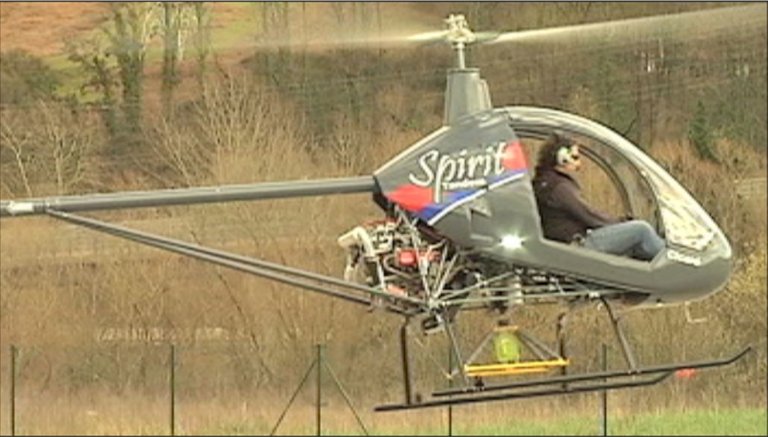The rotating wings

...
ARATZ ARREGI; Aeris Naviter: We often say that we have a virus inside us. In the end, I think it's this virus that drives you to dedicate your life to it.
UGAITZ ITURBE; Aeris Naviter: I studied at the Andra Mari school in Amorebieta, and it's just that part of the entrance to the Loiu airport. So, when we were walking around the playground, I always saw planes and I think that's where the virus got into my body.
ARATZ ARREGI; Aeris Naviter: a different point of view, a different point of view of the world. In the end you go at a height, the world moves at a speed and other parameters, it's beautiful.
Aeris Naviter opened its doors in Billabona 6 years ago. Aratz is an engineer and the pilot Ugaitz and one of the few helicopter companies in the Basque Country were then deployed. Currently, two seat ultra-light helicopters are manufactured in collaboration with an Argentine company. In the workshop, the 8th machine to be marketed is being manufactured.
ARATZ ARREGI; Aeris Naviter: What a helicopter has to guarantee is to fly and fly safely. In this case, we have another bonus: The helicopter must fly safely and also be light. If it is not light, it will not be included in any specific legislation, so it will not be accepted as an ultra light helicopter.
ARATZ ARREGI; Aeris Naviter: The empty helicopter, that is, without a pilot and with all the oil and fluids inside, should have a maximum weight of 280 kilos. That’s the biggest problem every producer has. It's something we're improving from machine to machine.
ARATZ ARREGI; Aeris Naviter: we started with 279.8; now 275.
UGAITZ ITURBE; Aeris Naviter: Now the chassis has arrived; in the first phase: the chassis, the rotor and the landing gear arrive. We remove the packaging first, then see if everything is ok and if we have to do a review, we do it in this phase.
THE CHASSIS
ARATZ ARREGI; Aeris Naviter: The frame is made of 4130 steel which is an alloy of moulidene chromium. It’s very stiff with incredible strength, but it’s mostly light. The cabin and the blades are made, for example, of composite material, such as fiberglass.
Our next technological leap is to move from glass fiber to carbon fiber.
With that, we'll have a weight reduction of about 35%. We can have a drop of about eight kilos and that's a world.
THE ROTOR
ARATZ ARREGI; Aeris Naviter: The key is the rotor system in helicopter and rotary aircraft systems. If I take the cab out of a helicopter, it will fly the same way; if I take the engine out of a helicopter and throw it out of 5000 meters, it will fly the same way. He will remove the skates from a helicopter and fly, but he will remove the rotor from a helicopter and not fly.
ARATZ ARREGI; Aeris Naviter: This is the main transmission box of the rotor, this is the heart of the helicopter. This is where the power from the motor enters the two rotors. To the tail rotor and the main rotor. This command, confusing the commands we give you with our command system. In spite of this, it is left to right.
ARATZ ARREGI; Aeris Naviter: The main peculiarities that you see here are the following. This one here is a metal chip detector or turn detector, thanks to which we would know in the cabin if there are any problems in any gear. If the pinion or the plates had any problems we would know thanks to this; whether or not it has detected metallic particles in the oil. This here is a temperature sensor and in the end this is the output of the lubrication system.
ARATZ ARREGI; Aeris Naviter: Too much innovation in aeronautics is bad. And we have to get that tattooed on our forehead. In a car the engine can fail and turn on the flasher, put on the triangle, put on the vest and you’re done. Not in aeronautics: If the engine fails, you're screwed.
THE ENGINE
ARATZ ARREGI; Aeris Naviter: An aeronautical engine that is currently mounted 70-80.hamarkadan is an almost identical engine that was mounted on cars. They are engines tested many times, with hundreds of thousands of hours, and finally with reliable basic systems. an engine of about 1500, four times, 100 horsepower, 100 horsepower when we're in the takeoff position, and it's just very simple. The petrol used is simple, not general aviation petrol, but 95-98 petrol used in cars.
THE SHOVELS
ARATZ ARREGI; Aeris Naviter: The blades we assemble now have a symmetrical profile, so the obvious stability in terms of strength is medium and they are blades made of glass fiber. But our next jump will be in composite materials. Those with an asymmetrical profile, as I said, will make machines more nervous. The nerves in the crocodiles will be more intense, but at the same time they will improve this weight-power ratio. That is, we will have more power available.
ARATZ ARREGI; Aeris Naviter: They are usually for recreation, or for instruction related to recreation, for pilot schools. But now with these last two machines we have managed to expand the market a little more and within this market we will have the opportunity to develop those that are called aerial works or aerial work.
ARATZ ARREGI; Aeris Naviter: The system we have here is a barycentric hook. Varicentric why? If you finally find out, it’s always vertical. The helicopter can lean to one side, to the other, and the hook will always maintain its verticality. This is very important when we carry the load for the most part. As long as the load can make a certain balance, with this hook we can maintain the verticality.
Buletina
Bidali zure helbide elektronikoa eta jaso asteroko buletina zure sarrera-ontzian











